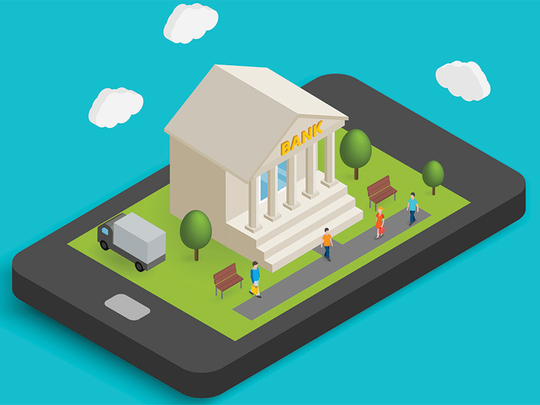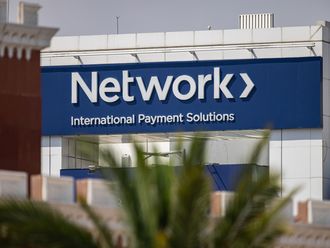
Just like cash or a debit card, the future of banking can fit into the palm of your hand. Smartphone banking apps are reaching an ever wider audience and creating novel pressures for the country’s banks. Not only do they have to compete with each other to continually improve their digital services but they are also faced with tricky questions such as what to do with their branch networks. The answers they come up with will shape the UAE’s banking landscape for years to come.
Not all banks in the country have launched a smartphone app but the number is growing all the time. Those that have range from giants such as Emirates NBD and National Bank of Abu Dhabi (NBAD) to smaller players like RAK Bank. Typically, their apps allow customers to transfer money between accounts, pay utility and other bills, and locate nearby ATMs and branches.
Customer-centric design thinking
Simply launching an app is not enough though. Once out there it needs to be regularly improved. Mashreq, for example, launched its first mobile app in 2008 and earlier this year released its fourth major upgrade. “The biggest change we have done is to the user experience,” says Aref Al Ramli, Head of Electronic Business and Innovation at Mashreq. “We have taken a bold step in animating the design. We’ve looked at it from the customer experience, making it easier to access with fewer clicks.”
While banks are investing in their digital services, they still have to make up ground. According to a November survey of 2,000 GCC bank customers by EY, 34 per cent of UAE respondents use a mobile banking service but only 45 per cent are happy with it. When asked why they don’t use mobile banking more, 51 per cent said they found it difficult to access. Other common gripes included slow transaction speeds and a non-intuitive user experience.
“Mobile banking has been a spectacular failure so far in the GCC,” says Ashar Nazim, Financial Services Customer Leader for the Middle East at EY. “The journey is still starting. There is a long way to go.”
While there is room for improvement, the direction of travel seems clear enough, with more and more customers using digital channels instead of visiting a branch. And banks are discovering that consumers have clear preferences for using different platforms for different things.
“While internet banking remains the platform of choice for service requests such as statements, applications for new products and information requests, mobile banking is becoming the platform of choice for transactions,” explains Sagheer Mufti, Chief Operating Officer at Abu Dhabi Islamic Bank. “We [saw] an increase of 71 per cent in the number of transactions conducted on the mobile app in 2015.”
Social the right path?
In addition to straightforward banking apps, a few institutions have been experimenting with other services delivered via apps. Emirates Islamic Bank, for example, has developed the EI World app where, in return for carrying out transactions such as paying utility bills, users can accumulate points that can be redeemed for vouchers. Abu Dhabi Commercial Bank and Emirates NBD offer similar offerings.
Potentially more interesting are the moves to develop services via other online platforms and apps, including social media networks like Facebook and Twitter. In October 2014, Commercial Bank of Dubai opened a branch on Facebook that offers many of the same functions as a dedicated banking app. Last year, Emirates NBD started offering balance enquiries and other services on Twitter.
There are security concerns that tend to limit the scope of such initiatives, but all banks need to keep an eye on such developments lest they lose ground to their rivals, particularly among the next generation of customers. However, not everyone is convinced there is enough demand.
“We’re not hearing any strong signals from our customer base that they need us to facilitate their banking on their social media channels,” says Suvrat Saigal, Managing Director and Head of Global Retail at NBAD. “We’re focusing our resources on where we know our customers want us to improve, rather than take a me-too approach to channel investment.”
Branches still a thing
However, what seems inevitable is that digital channels will become ever more important for banks and, as smartphone technology becomes increasingly sophisticated, more people will want to bank via their phones. This, in turn, raises a question about the role of traditional physical branches and whether banks even need them. Most executives insist there is still a role for branches, particularly when it comes to dealing with more complex services such as investment advice, but at the very least the expansion of branch networks is likely to slow down.
“Branches will continue to be important,” says Mosabah Al Qaizi, Head of Electronic Banking Services at Dubai Islamic Bank. “We envision that they will be leaner in size with a focus on performing more complex transactions.
“Our aim will also be to continue opening more technologically advanced express banking centres and expanding our full function ATM network, while we see a slowdown in opening large brick-and-mortar branches.”
Through the longer term, the need for branches could be even further eroded. The EY survey found that 60 per cent of customers in the UAE would willingly switch to a digital-only bank.










